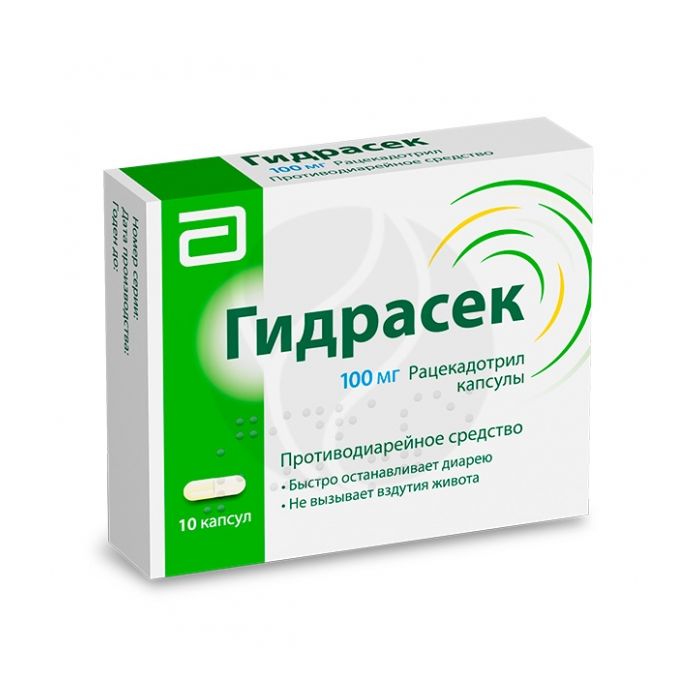Hydrasek capsules 100mg, No. 10
Expiration Date: 05/2027
Russian Pharmacy name:
Гидрасек капсулы 100мг, №10
For oral administration. The first capsule at the beginning of treatment is taken regardless of the time of day. Next - 1 caps. 3 times / day before meals.
Treatment should be continued until stool normalization (normal feces appear up to two times), but no more than 7 days. Long-term use of racecadotril is not recommended.
No dose adjustment is required for elderly patients.
Hard gelatin capsules
Active substance:
racecadotril
hypersensitivity to the active substance or any other component of the drug;
congenital galactose intolerance, lactase deficiency, glucose-galactose malabsorption syndrome (due to the fact that the drug contains lactose);
pregnancy;
breastfeeding period;
children under 18 years of age (due to the high content of the active substance).
pharmachologic effect
Racecadotril is a prodrug that is hydrolyzed to its active metabolite, thiorphan, which is an inhibitor of enkephalinase, a surface peptidase (located on the cell membrane) localized in various tissues, especially in the epithelium of the small intestine. This enzyme is responsible for both the hydrolysis of exogenous peptides and the degradation of endogenous peptides such as enkephalins. As a result, racecadotril protects endogenous enkephalins, which exhibit physiological activity at the level of the digestive tract, prolonging their antisecretory effect.
Racecadotril is an intestinal antisecretory substance. Reduces intestinal hypersecretion of water and electrolytes caused by cholera enterotoxin or inflammation, and does not affect basal intestinal secretion.
Racecadotril has a rapid antidiarrheal effect without altering the transit time of intestinal contents through the intestines.
Racecadotril does not cause bloating.
In clinical studies, the incidence of secondary constipation with racecadotril was comparable to placebo.
Indications of the drug Hydrasek
symptomatic treatment of acute diarrhea in adults.
Dosage regimen
For oral administration. The first capsule at the beginning of treatment is taken regardless of the time of day. Next - 1 caps. 3 times / day before meals.
Treatment should be continued until stool normalization (normal feces appear up to two times), but no more than 7 days. Long-term use of racecadotril is not recommended.
No dose adjustment is required for elderly patients.
Side effect
The following adverse reactions were reported more frequently with racecadotril than with placebo, or were reported during post-marketing use.
From the nervous system: often (? 1/100, <1/10) - headache.
Skin and subcutaneous tissue disorders: infrequently (? 1/1000, <1/100) - skin rash, erythema; the frequency is unknown (to assess the frequency of cases, the available data are not enough) - polymorphic erythema, edema of the tongue, edema of the face, edema of the lips, edema of the eyelids, angioedema, urticaria, erythema nodosum, papular rash, prurigo, pruritus, toxic dermatitis.
Contraindications for use
hypersensitivity to the active substance or any other component of the drug;
congenital galactose intolerance, lactase deficiency, glucose-galactose malabsorption syndrome (due to the fact that the drug contains lactose);
pregnancy;
breastfeeding period;
children under 18 years of age (due to the high content of the active substance).
Application during pregnancy and lactation
There are no sufficient data on the use of racecadotril by pregnant women. Animal studies have shown no direct or indirect adverse effects on pregnancy, embryonic development, childbirth or postpartum development. However, due to the lack of clinical data, Hydrasek should not be used during pregnancy.
Due to the lack of information on the excretion of racecadotril into breast milk, Hydrasek should not be used during breastfeeding.
Application for violations of liver function
Due to the lack of data, racecadotril should be used with caution in patients with hepatic impairment.
Application for impaired renal function
Due to the lack of data, racecadotril should be used with caution in patients with renal insufficiency.
Application in children
The use of the drug is contraindicated in children under 18 years of age (due to the high content of the active substance). Use in elderly patients
No dose adjustment is required for elderly patients.
special instructions
The use of the drug Hydrasek does not exempt from oral rehydration in cases where it is necessary.
The presence of bloody or purulent stool discharge and a high fever may be symptoms of an invasive bacterial infection causing diarrhea or other serious illness, which warrants etiotropic therapy (eg, antibiotics) or further investigation. Racecadotril monotherapy is contraindicated in these conditions. Racecadotril can be used in conjunction with antibiotics as an adjunctive therapy for acute bacterial diarrhea.
Due to insufficient data, it is not recommended to use racecadotril for antibiotic-associated diarrhea and chronic diarrhea.
Due to the lack of data, racecadotril should be used with caution in patients with renal and hepatic impairment.
The bioavailability of racecadotril may be reduced by repeated vomiting.
The use of the drug Hydrasek does not affect or has a slight effect on the ability to drive a car and mechanisms.
Overdose
Currently, there are isolated cases of overdose without side effects.
In adults, taking a single dose of the drug more than 2 g, equivalent to a 20-fold therapeutic dose, did not cause adverse effects.
Drug interactions
There are currently no data on interactions with other drugs.
Loperamide or nifuroxazide do not affect the kinetics of racecadotril when these drugs are used together.

